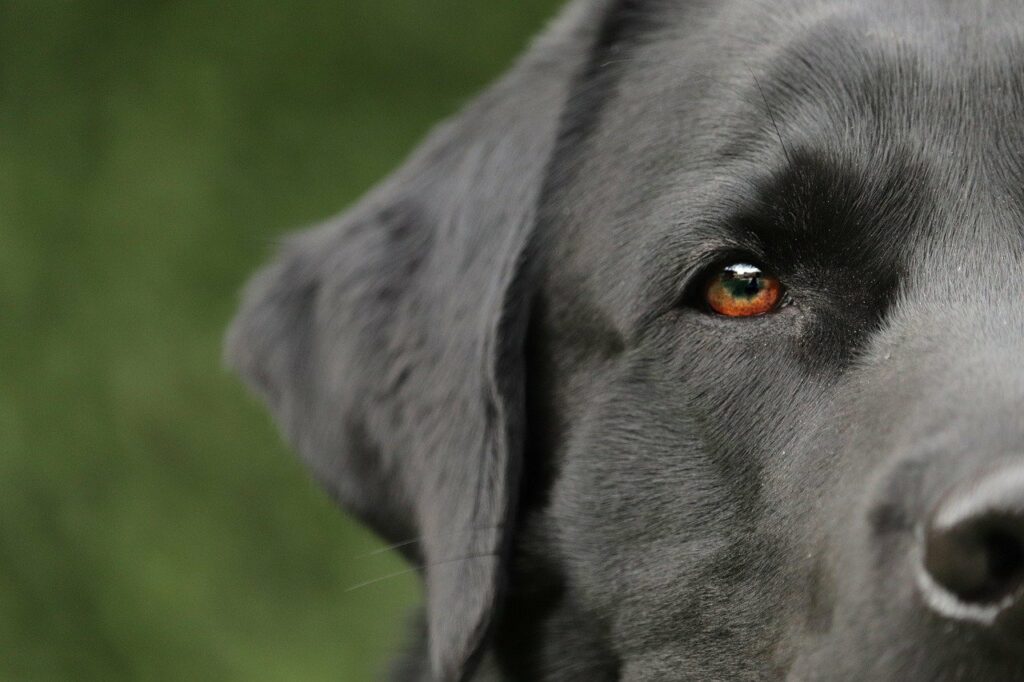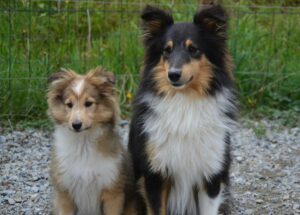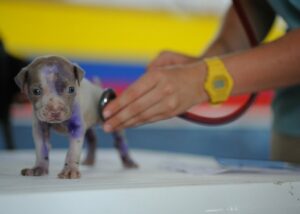Description
Labrador Retrievers are much loved around the world, and it’s easy to see why! This medium-large breed has a strong and muscular physique, but they are gentle and kind-natured dogs. They have a broad and thick chest, strong neck and powerful hindquarters. The legs are strong and athletic, and in proportion to the body.
The most endearing feature of the Labrador Retriever is the face – with an open and friendly expression they are hard not to love! They have a long wide nose, gentle and expressive eyes, and ears which droop around the face. When spoken to, the Labrador will often tip it’s head to one side and cock an ear, giving the impression that they are listening intently to their owner.
Labrador Retrievers come in three coat colors – black, chocolate and yellow. They are always solidly colored, with no white markings. The coat is made up of two layers – a short dense weather-resistant undercoat and longer wiry top coat. This coat makes the Labrador Retriever tough and adaptive to cold and wet weather, and also well suited to swimming.
This lovable breed needs to be around humans, and is not well-suited to being alone for long periods. Although they are gentle and good natured, they have high levels of energy and need plenty of exercise. Also, just because Labrador Retrievers are obedient they still require training – that cute puppy can soon turn into an unruly dog if left to its own devices!

Common health problems
Labrador Retrievers are generally healthy and athletic dogs, but like all pedigree breeds they are susceptible to certain health problems. If you are buying a Labrador puppy then a reputable breeder should have screened the parents for health conditions such as hip dysplasia and eye disorders.
Hip Dysplasia
Hip dysplasia is a hereditary condition which causes the hip joints to form improperly, leading to arthritis. It is unfortunately very common to see Labrador Retrievers with weakness in the hindquarters, caused by hip dysplasia. If you are purchasing a Labrador puppy it is essential to check with the breeder that the parents have been screened for hip dysplasia. Hip dysplasia is a painful lifelong condition which can require long-term medication or expensive surgical treatment.
Elbow Dysplasia
Another hereditary condition, elbow dysplasia occurs when the elbow joint develops abnormally, causing painful arthritis. This causes forelimb lameness and limited movement of the elbows. The consequences are a painful and limited movement of the elbows and limping of the front legs. Surgical treatment may reduce the symptoms, but long-term medication may be required.
Progressive Retinal Atrophy
This degenerative condition affects the photoreceptors in a dog’s eyes, leading to gradual loss of vision and eventually blindness. Progressive Retinal Atrophy (PRA) is not a painful condition, but it can affect the dog’s quality of life.
One of the first symptoms of PRA is reduced vision in poor light, also known as night blindness. The pupils of the eye may also look more dilated than normal, and you may notice that the eyes look reflective when light shines on them. There is currently no known treatment for PRA, but your vet will be able to advise on how to keep your dog comfortable following a diagnosis.
Epilepsy
Epilepsy is a brain disorder that results in seizures or fitting. These seizures are generally not painful but can be distressing for both dog and owner. Depending on the severity, these seizures may need to be controlled with lifelong medication. If your Labrador Retriever has a seizure it is important to seek veterinary advice, to check for underlying conditions such as brain lesions or metabolic disorders
Personality traits
Labrador Retrievers are smart and obedient dogs. They get along well with children and other pets, and are very gentle, friendly and patient. However, these are big dogs and sometimes forget their own size. They should be supervised when with small children and pets. It is also advisable to keep precious objects such as ornaments away from that powerful waggy tail – an excited Labrador can unintentionally be very destructive!

This is a very athletic breed, and Labrador Retrievers require a lot of attention and play. They will not thrive if left alone for long periods – this is a dog which wants to be part of family life. Labradors are rarely aggressive and hardly ever bark, except when excited. It is important to remember that these dogs take a long time to reach mental maturity. In fact, some geriatric Labradors still behave like a puppy, so be prepared for a lifetime of fun and games!
Care
Labrador Retrievers are generally quite easy to care for, but they do have some specific care needs to help prevent health problems. These energetic dogs require plenty of exercise, and they need mental stimulation otherwise behavioural problems may develop.
Grooming
Labrador Retrievers have a dense double coat; this becomes thicker in the winter and the main shedding season is spring. A weekly groom with a soft brush will be sufficient to remove loose hair and keep the skin healthy. During shedding season a grooming mitt is useful to remove the finer hairs. Labradors adore rolling in mud and anything else they can find, so be prepared to bath this dog more frequently than some other breeds!
Check the ears regularly for signs of infection, particularly if your Labrador loves to swim. Keep the nails trimmed to prevent breakages and snagging. Brushing the teeth daily will help to maintain good dental health and prevent dental disease.
Feeding
Labradors are very motivated by food – this makes them easy to train but take care to avoid excessive treats which may lead to obesity! This breed does not have any special dietary requirements and will normally thrive on a good quality complete diet. Weigh the food to accurately monitor your Labrador’s food intake. Split this food into at least two meals per day to prevent bloating. It is important to weigh your Labrador regularly to monitor for weight gain – these food-loving dogs will happily overeat if given the chance!
Training
Labrador Retrievers are intelligent and eager to please. They are easily motivated by food and praise, making them fun and rewarding dogs to train. They are sensitive to human moods and respond well to clear and gentle instructions. As their name indicates, they are excellent at retrieving, and will play games of fetch all day long.
Labradors excel at obedience training, and training your puppy well will help to build a good foundation for life. With their high energy levels, retrieving instincts and eagerness to please, Labradors are well suited to sports such as field trials, hunting, and agility.
Like all retrievers, Labradors are happiest when they have something to carry in their mouth. Many Labradors will have a favorite toy which they will carry around, and they also like something hard to chew. Training is important so they will only chew their own toys, and not your clothes, shoes or furniture!
Exercise
Labrador Retrievers are full of energy and love to run and play! Their daily walk should be at least one hour long and include a combination of walking and running. Walking will help to build and maintain muscle, while running allows your Labrador to release pent-up energy. Labradors also need daily play time and the chance to roam free in an enclosed garden. This helps to give plenty of mental stimulation as well as physical exercise.
Luckily Labradors are happy to exercise in all weathers, and their thick weatherproof coat means that they will stay warm and dry. Take care in warmer weather, as your Labrador will struggle to stay cool if exercised in the heat of the day.

History
Labrador Retrievers originate from the Labrador Peninsula in Newfoundland, Canada. Initially, Labradors were used as fishing dogs, retrieving fish who had escaped hooks and towing in lines. They are descended from a breed of dog called St John, which it is believed was bred with the Newfoundland dog to create the Labrador Retriever.
The dog’s usefulness and good disposition was soon noticed by outsiders, and Labradors were imported to England to serve as retrievers for hunting. Their soft mouth and excellent retrieving skills meant they soon became popular with the English gentry for hunting birds such as ducks and grouse.
Today, as well as being popular family pets, Labradors are widely used as service dogs. Their gentle nature makes them excellent therapy dogs, and they are often the first choice as assistance dogs. They are very talented at search and rescue, and as sniffer dogs for drug and explosive detection.
Interesting facts
- The Labrador Retriever has come top of the most popular breeds list in America for 28 years in a row. We really do love our Labradors!
- Labradors are exceptional swimmers and are uniquely adapted to the water. Their thick otter-like tail is used as a powerful rudder, webbed feet propel them quickly through the water, and their thick, waterproof coats keep them warm and dry.
- Labradors were almost extinct by the 1880s, and if it wasn’t for the efforts of a handful of Labrador enthusiasts who saved the breed we wouldn’t have these wonderful dogs today!










